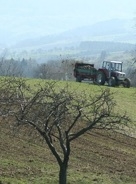
Features
Applications
Manure Management
Other
Research
Fall manure management
October 9, 2012 by Penn State Extension

October 9, 2012 – When corn silage harvest is done, one of the next jobs we will be looking at is spreading manure.
Two important considerations for fall manure application are timing and cover crop management. The best scenario would be if we did not have to apply manure in the fall for corn the next year. With fall applications, significant nutrient losses are almost inevitable because the manure is lying on the field for a long period of time.
There are some things that we can do to reduce these losses. Probably the most important thing that we can do is to establish a cover crop where manure will be applied in the fall or winter. Having a cover crop will generally double the recovery of fall and winter applied manure N by next year’s corn crop. Also, if you plan to apply manure during the winter, state regulations require that you either have greater than 25 percent residue, or an established cover crop. In bare corn silage ground, a cover crop is the only option for meeting this regulation.
Manure can be applied before, or after cover crop establishment. Generally, the priority should be getting the cover crop established, and then spreading manure. This gets the cover crop established in a timely fashion to insure good cover going into the winter. It also delays manure application, which reduces the time the manure is exposed for loss. It allows the cover crop to start growing so that when manure is applied, the cover crop will be ready to take up the manure nutrients to hold them against loss. Finally, delaying will maybe get us into colder weather, so the manure nutrients will not be released as rapidly, reducing the exposure of the available nutrients to loss.
The main downside to applying manure after cover crop establishment is the potential for smothering if high solids manure is applied at a heavy rate. In some cases, applying manure before cover crop establishment is necessary; for example if the storage is full. This will delay cover crop planting until the manure and the soil have dried out enough for planting. Also, with early fall manure applications when the weather is still warm, there is much greater potential for manure N to volatilize unless it is quickly incorporated by tillage or rain.
The loss of N at this time of year is similar to what we see with surface applications in the spring. Most of this loss occurs within the first two days after application, so if incorporation is not immediate, then there will be little or no N benefit from fall tillage. This creates a dilemma because, while fall tillage may reduce N loss, it opens us up to other losses mainly through erosion. The erosion factor can be reduced if a cover crop is established, but now we are looking at harvesting silage, spreading manure, tilling the soil, and finally planting the cover crop which could get us pretty late into the fall before all of this is done. Low disturbance injectors would be a good alternative for this early fall application, because they get the manure incorporated immediately, no tillage is required, and the cover crop can be planted much sooner.
One final note on fall manure application: Pay attention to soil conditions. Driving heavy manure application equipment on wet soils can result in severe soil compaction that may take years to rectify. This is another reason to get the cover crop established and delay manure applications until better soil conditions are present.